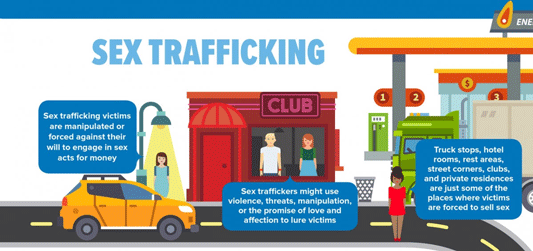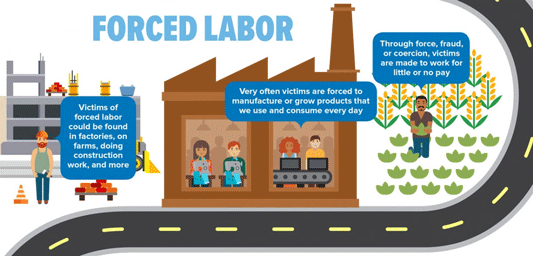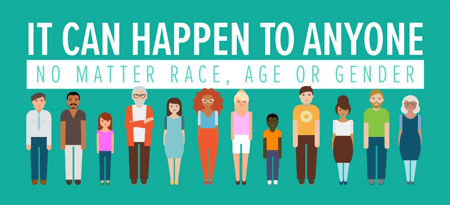In an effort to integrate human trafficking elements into Pennsylvania’s child abuse law, the General Assembly now recognizes human trafficking as a form of child abuse and neglect. Act 115 of 2016 added “engaging a child in a severe form of trafficking in persons or sex trafficking” as part of the definition of child abuse. This includes both sex trafficking and labor trafficking of children.
Act 115 of 2016:
- Adds a category of child abuse to include:
- Engaging a child in a severe form of trafficking in persons or sex trafficking, as those terms are defined under section 103 of the Trafficking Victims Protection Act of 2000;
- Adds a category of perpetrator to include:
- an individual 18 years of age or older who engages a child in severe forms of trafficking in persons or sex trafficking, as those terms are defined under section 103 of the Trafficking Victims Protection Act of 2000.
- Provides for additional grounds for involuntary termination of parental rights.
- Provides for additional grounds for aggravated circumstances.
- Allows for release of information in confidential reports to law enforcement when investigating cases of severe forms of trafficking in persons of sex trafficking.
What Is Human Trafficking?
The scale of human trafficking is atrocious. The silence that conceals this crime is disgraceful. We have to speak out because the victims are living in fear for their lives. We have to raise our voices for them. That means confronting the social and economic conditions that abet this crime. It means arresting the traffickers. And above all, it means protecting the victims.
Ban Ki-moon
Former U.N. Secretary General
Human trafficking is the recruitment, harboring, transportation, provision, or obtaining of a child or adult for sex, labor, or services through the use of force, fraud, or coercion. It is a widespread problem, affecting about 21 million people worldwide. As with many other countries, the United States is both a source and a destination for U.S. citizens and foreign nationals who are subjected to sex trafficking and forced labor (Hemmings et al., 2016).
Adults and children are exploited in both legal and illegal industries, including in commercial sex, hospitality, traveling sales crews, agriculture, seafood, manufacturing, janitorial services, construction, restaurants, healthcare, care for persons with disabilities, salon services, fairs and carnivals, peddling and begging, drug smuggling and distribution, child care, and domestic work (USDOS, 2017).
In Pennsylvania during 2016, the National Human Trafficking Hotline received 580 phone calls, 96 emails, and 68 online tip reports related to human trafficking in the state. This was the twelfth highest call volume in the country (NHTH, 2017). These calls resulted in 151 reports of human trafficking, of which 72% were related to sex trafficking and 16% were for labor trafficking. A little more than a quarter of the reported cases involved minors.
What Is Child Sex Trafficking?
Any child under the age of 18 who is manipulated or forced to engage in sex acts for money (or for anything of value) is a victim of sex trafficking. Severe forms of human trafficking include sex trafficking in which a commercial sex act* is induced by force, fraud, or coercion, or in which the person induced to perform such act has not attained 18 years of age.
*Commercial sex act: any sex act in which anything of value is given to or received by any person.
When a child under 18 years of age is recruited, enticed, harbored, transported, provided, obtained, patronized, solicited, or maintained to perform a commercial sex act, proving force, fraud, or coercion is not necessary for the offense to be prosecuted as human trafficking. There are no exceptions to this rule: no cultural or socioeconomic rationalizations alter the fact that children who are exploited in prostitution are trafficking victims (USDOS, 2017).
The use of children in commercial sex is prohibited under U.S. law and by statute in most countries. Sex trafficking has devastating effects on children, causing long-lasting physical and psychological trauma, disease (including HIV/AIDS), drug addiction, unwanted pregnancy, malnutrition, social ostracism, and even death (USDOS, 2017).

Source: Department of Homeland Security. From: https://www.dhs.gov/blue-campaign/infographic.
Child Labor Trafficking
Labor trafficking is the use of force, fraud, or coercion to recruit, harbor, transport, or obtain a person for the purpose of subjection in involuntary servitude, peonage1, debt bondage2, or slavery3.
1Peonage: paying off debt through work.
2Debt bondage: debt slavery, bonded labor, or services for a debt or other obligation.
3Slavery: a condition compared to that of a slave in respect of exhausting labor or restricted freedom.
Labor trafficking includes agricultural, factory, and domestic service workers who are underpaid or not paid at all, physically abusive traveling sales crews that force children to beg, sell legal items (such as magazines), or illegal items (such as drugs). It also includes workers in restaurants, hair, and nail salons who are abused, confined, or not paid (PAFSA, 2017).
Although children may legally engage in certain forms of work, children can also be found in slavery or slavery-like situations. Some indicators of forced labor of a child include situations in which the child appears to be in the custody of a non-family member who requires the child to perform work that financially benefits someone outside the child’s family and does not offer the child the option of leaving (USDOS, 2017).

Source: Department of Homeland Security. From: https://www.dhs.gov/blue-campaign/infographic.
Who Are the Victims?
Victims of human trafficking come from almost every region of the world. The top three countries of origin of federally identified victims in fiscal year 2016 were the United States, Mexico, and the Philippines (USDOS, 2017). Populations at particular risk for victimization in the United States include:
- Children in the child welfare, foster care, or juvenile justice systems
- Runaway and homeless youth
- Unaccompanied children
- American Indians and Alaska Natives
- Migrant laborers, undocumented workers, and participants in visa programs for temporary workers
- Foreign national domestic workers in diplomatic households
- Persons with limited English proficiency
- Persons with low literacy
- Persons with disabilities
- LGBTI individuals (USDOS, 2017).
Individuals with certain histories—such as sexual abuse, violence, substance abuse, family dysfunction, or untreated mental health disorders—are considered at increased risk for human trafficking. Adults and children who enter the United States with or without legal status have been identified as trafficking victims. There is ongoing concern about the risk of human trafficking in global supply chains, including in federal contracts (USDOS, 2017).

Source: Department of Homeland Security. From: https://www.dhs.gov/blue-campaign/infographic.
Recognizing Warning Signs
Human trafficking is associated with high levels of physical and sexual violence prior to and during trafficking as well as a range of health problems in the post-trafficking period. Studies with survivors have identified a high prevalence of depression, anxiety, and post-traumatic stress disorder, and symptoms such as headache, fatigue, dizziness, and back and stomach pain (Hemmings et al., 2016).
Medical and psychological care is urgently needed, although there is little evidence-based guidance available on how to plan, assess, or provide for the health needs of trafficked adults and children. Many healthcare professionals feel they have insufficient knowledge and lack confidence about how to respond appropriately to the needs of trafficked people (Hemmings et al., 2016).
Recognizing warning signs and key indicators for human trafficking of young people is the first step in identifying victims. Healthcare providers must be aware of these warning signs in boys and girls under that age of 18:
- Is involved in the commercial sex industry, or has a prior arrest record for prostitution or related charges.
- Has an explicitly sexual online profile.
- Frequents internet chat rooms or classified sites.
- Depicts sexual exploitation in drawing, poetry, or other modes of creative expression
- Presents with frequent or multiple sexually transmitted diseases or pregnancies.
- Lies about or unaware of his or her true age.
- Has no knowledge of personal data, such as date of birth.
- Has no identification.
- Wears sexually provocative clothing, has new clothes, gets hair and nails done with no financial means.
- Expresses secrecy about whereabouts.
- Keeps late nights or unusual hours.
- Has a tattoo that he or she is reluctant to explain.
- Is in a controlling or dominating relationship.
- Does not have control of own finances.
- Exhibits hyper-vigilance or paranoid behaviors.
- Expresses interest in or is in relationships with adults or much older men or women.
Healthcare Provider Responsibilities
Human trafficking is a criminal form of extreme exploitation and abuse, from which individuals suffer multiple physical, psychological, and sexual and reproductive health problems. Responding to survivors’ needs requires that healthcare providers adopt trauma-informed and culturally sensitive approaches, conduct comprehensive health assessments, and participate in a reliable referral network, including law enforcement and voluntary support services (Hemmings et al., 2016).
Training should include information about referral and support options for trafficked people as well as reporting requirements. At the local level, healthcare providers should establish referral pathways, create trustworthy points of contact, and share information with relevant agencies. More research is urgently needed to enable healthcare providers to identify, refer, and care for victims of trafficking (Hemmings et al., 2016).
Back Next